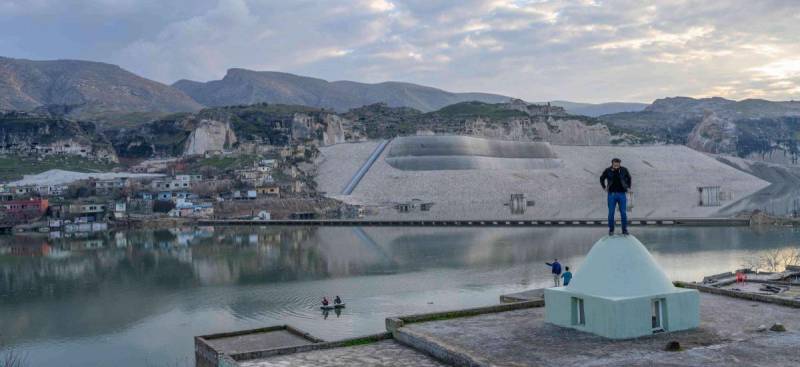Turkey launched its Southeastern Anatolia Project (Güneydoğu Anadolu Projesi, GAP), some 40 years ago.
The GAP is one of the largest river basin development projects in the world and the largest single development project carried out by Turkey. It includes 13 irrigation and hydropower schemes, involving the construction of 22 dams and 19 hydroelectric power plants on both the Tigris and the Euphrates rivers.
Turkish authorities maintained that the GAP would lead to the creation of four million new jobs in a region with an unemployment rate twice the national average.
But it has failed to bring the promised prosperity and employment to the region, let alone to the southern province of Urfa, the centre of the project.
The project’s challenges show how traditional modernisation theory can fail in an area suffering from centuries of socio-economic and political grievances.
In the last 15 years, seasonal labour has become one of the main livelihoods in almost all provinces in the GAP’s coverage area, including Adıyaman, Batman, Diyarbakır, Gaziantep, Kilis, Mardin, Siirt, Şanlıurfa and Şırnak, as the project failed to achieve adequate development and job growth.
These provinces, especially Urfa, frequently come to media’s attention due to deaths of seasonal workers, as thousands of people of the region migrate to other cities in order to find temporary jobs at farms.
So why did the GAP turn into such a fiasco?
Launched officially in the 1970s, the project was initially a largely state-led and mainly infrastructural and economic development-oriented project
With a more comprehensive plan prepared in 1989, GAP was transformed into an integrated development project also overseeing social development; including education, health, rural and urban infrastructure investments and youth centres. It was planned to be completed in 2010.
The team which was responsible for managing the project before 2002 consisted of the most qualified development officials in Turkey. It was led by Olcay Ünver, one of Turkey’s most competent bureaucrats, and was like a school that trained Turkey’s future development officials. I always consider myself lucky to have worked with such a well-equipped team for many years as a project coordinator for the GAP Entrepreneur Support Centers Project (GIDEM) of the United Nations Development Program (UNDP).
As soon as the ruling Justice and Development Party (AKP) came to power in 2002, it dismissed almost all the skilled members of the GAP’s technical team, including Ünver.
In 2008, then Prime Minister Recep Tayyip Erdoğan announced a new action plan in which four strategic development axes were identified: achieving economic development, ensuring social development, developing infrastructure, and improving institutional capacity.
The main goal of the action plan was to “bring prosperity, peace and happiness to the region,” Erdoğan said on May 27, 2008, during a press conference.
But GAP brought neither prosperity, peace nor happiness to the region.
The fourth leg of the new action plan, improving institutional capacity, was stillborn with the sacking of Turkey’s most qualified officials.
The economic development envisaged in the plan was not possible the government couldn’t provide incentives that would make investment in the troubled region attractive or compensate for the possible risks.
The target of bringing the region’s struggling economy closer to the country’s average in areas such as education, health, employment, social services, and culture – part of the plan for social development – has not been achieved because the necessary investment has not been made in this area. Maybe a little more help went to poor people in the region during this period, but strategies to effectively eliminate poverty were not adopted.
Let’s look at the achievements in terms of infrastructure: only 13 of the 19 hydroelectric power plants under the project have been completed and the construction of 19 of the planned 22 dams have been completed, according to the 2018 figures.
The target of the project was to also provide irrigation systems for 1.8 million hectares, but only 558,507 hectares of land have been opened for irrigation. Overall, 74 percent capacity was achieved in the energy projects in 40 years, and 53 percent in irrigation projects. Furthermore, the energy components of the project generally prioritise providing power to the whole country, not the district.
Irrigation was the main component intended to generate benefits in the region. Unfortunately, irrigation projects did not go hand in hand with other infrastructure and social investments, and much of the money generated enriched landlords and landowners rather than the poor people. How this happened exceeds the scope of this article, I will touch on this topic in another one.
Beyond all these cause and effect relationships, of course, the conflict between the Turkish state and the Kurdistan Workers Party (PKK) that continues in the region is the biggest factor in the failure to reach the basic goals of the project even after 40 years. As long as the war continues, few investors will come or create employment, and the “prosperity, peace and happiness” Erdoğan mentioned will never materialise.
The people of the region will still die on the roads as seasonal workers, will still sweat blood at the constructions sites in the West, and their children will still grow up collecting the garbage of Turkey’s largest cities like Istanbul and Izmir.
Now, after 40 years, we need to look back and figure out our failures to make the best of the project.
